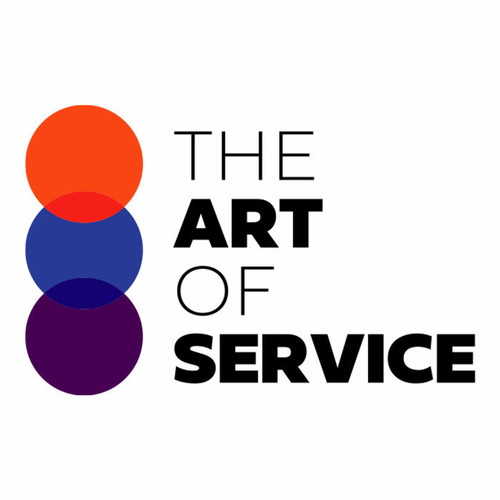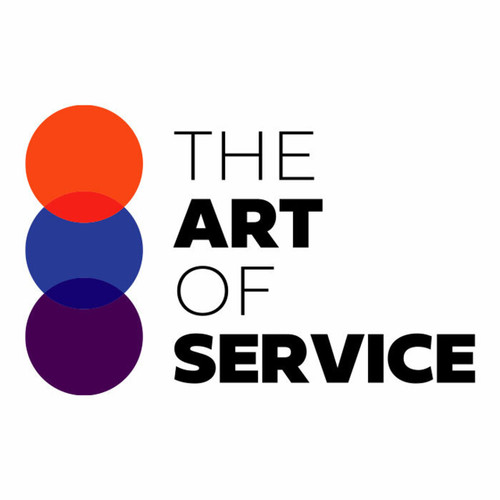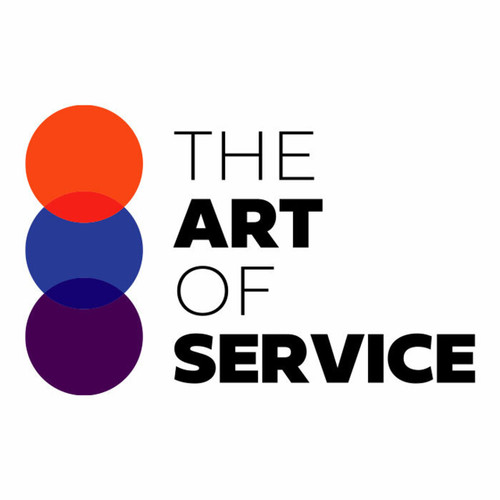Are you tired of wasting valuable time and resources searching for the most important questions to ask when dealing with data architecture and data obsolescence? Look no further, because our Data Architecture and Data Obsolescence Knowledge Base has got you covered.
This comprehensive database consists of 1502 prioritized requirements, innovative solutions, and real-life case studies to guide you in making urgent and impactful decisions for your company.
Our database covers a wide range of topics, from data architecture best practices to understanding the risks and challenges of data obsolescence.
No matter the scope or level of urgency, our Knowledge Base has the answers you need.
But what sets us apart from competitors and alternatives? Our data experts have carefully curated this dataset to provide you with the best and most relevant information.
We understand the importance of staying ahead in this ever-changing industry, and our Knowledge Base is continually updated to reflect the latest trends and developments.
And the best part? Our Data Architecture and Data Obsolescence Knowledge Base is accessible and affordable for all professionals.
Whether you′re a seasoned data architect or just starting out, our user-friendly interface makes it easy for anyone to use and implement.
While other products may offer similar services, none can compare to the depth and breadth of information provided in our Data Architecture and Data Obsolescence Knowledge Base.
We are dedicated to helping businesses save time, resources, and money by providing a DIY alternative that is cost-effective and efficient.
So why wait? Make the smart choice for your business and invest in our Data Architecture and Data Obsolescence Knowledge Base today.
By utilizing our valuable dataset, you can stay ahead of the competition, make informed decisions, and achieve better results for your company.
Don′t miss out on this opportunity to revolutionize your data strategy and drive success.
Get started now!
Discover Insights, Make Informed Decisions, and Stay Ahead of the Curve:
Key Features:
Comprehensive set of 1502 prioritized Data Architecture requirements. - Extensive coverage of 110 Data Architecture topic scopes.
- In-depth analysis of 110 Data Architecture step-by-step solutions, benefits, BHAGs.
- Detailed examination of 110 Data Architecture case studies and use cases.
- Digital download upon purchase.
- Enjoy lifetime document updates included with your purchase.
- Benefit from a fully editable and customizable Excel format.
- Trusted and utilized by over 10,000 organizations.
- Covering: Backup And Recovery Processes, Data Footprint, Data Architecture, Obsolete Technology, Data Retention Strategies, Data Backup Protocols, Migration Strategy, Data Obsolescence Costs, Legacy Data, Data Transformation, Data Integrity Checks, Data Replication, Data Transfer, Parts Obsolescence, Research Group, Risk Management, Obsolete File Formats, Obsolete Software, Storage Capacity, Data Classification, Total Productive Maintenance, Data Portability, Data Migration Challenges, Data Backup, Data Preservation Policies, Data Lifecycles, Data Archiving, Backup Storage, Data Migration, Legacy Systems, Cloud Storage, Hardware Failure, Data Modernization, Data Migration Risks, Obsolete Devices, Information Governance, Outdated Applications, External Processes, Software Obsolescence, Data Longevity, Data Protection Mechanisms, Data Retention Rules, Data Storage, Data Retention Tools, Data Recovery, Storage Media, Backup Frequency, Disaster Recovery, End Of Life Planning, Format Compatibility, Data Disposal, Data Access, Data Obsolescence Planning, Data Retention Standards, Open Data Standards, Obsolete Hardware, Data Quality, Product Obsolescence, Hardware Upgrades, Data Disposal Process, Data Ownership, Data Validation, Data Obsolescence, Predictive Modeling, Data Life Expectancy, Data Destruction Methods, Data Preservation Techniques, Data Lifecycle Management, Data Reliability, Data Migration Tools, Data Security, Data Obsolescence Monitoring, Data Redundancy, Version Control, Data Retention Policies, Data Backup Frequency, Backup Methods, Technology Advancement, Data Retention Regulations, Data Retrieval, Data Transformation Tools, Cloud Compatibility, End Of Life Data Management, Data Remediation, Data Obsolescence Management, Data Preservation, Data Management, Data Retention Period, Data Legislation, Data Compliance, Data Migration Cost, Data Storage Costs, Data Corruption, Digital Preservation, Data Retention, Data Obsolescence Risks, Data Integrity, Data Migration Best Practices, Collections Tools, Data Loss, Data Destruction, Cloud Migration, Data Retention Costs, Data Decay, Data Replacement, Data Migration Strategies, Preservation Technology, Long Term Data Storage, Software Migration, Software Updates
Data Architecture Assessment Dataset - Utilization, Solutions, Advantages, BHAG (Big Hairy Audacious Goal):
Data Architecture
Data architecture refers to the structure and organization of data within a system, including how it is stored, managed, and accessed.
1. Data migration to newer systems: This solves the problem of outdated hardware and software, ensuring data is accessible.
2. Data backups and archiving: Keeps legacy data accessible and secure, preventing loss or corruption.
3. Regular data auditing: Identifies outdated or duplicate data which can be removed, streamlining the system.
4. Utilizing cloud storage: Allows for scalable storage solutions without hardware concerns, ensuring data accessibility.
5. Implementing version control: Tracks changes to data and ensures the most up-to-date versions are being used.
6. Utilizing data virtualization: Creates a single source of data, eliminating data redundancy and increasing efficiency.
7. Utilizing data federation: Integrates data from various sources, allowing for a unified view of data.
8. Data cleansing and standardization: Ensures data accuracy and consistency, preventing errors and improving data quality.
9. Automated data updates: Keeps data up-to-date, reducing the need for manual updates and increasing efficiency.
10. Regular data review and updates: Ensures that data remains relevant and useful, avoiding obsolescence in the long run.
CONTROL QUESTION: Is the multi layered architecture introducing data synchronization and system management issues?
Big Hairy Audacious Goal (BHAG) for 10 years from now:
Yes, the goal for Data Architecture in 10 years from now is to develop a seamless and highly efficient multi layered architecture that eliminates data synchronization and system management issues.
This multi layered architecture will be designed to handle all types and volumes of data, including structured, unstructured, and real-time data. It will have the ability to integrate with multiple data sources and provide real-time data access to enable faster decision making.
With this architecture, the data will be stored in a centralized location, allowing for easy maintenance and management. Advanced analytics and machine learning algorithms will be incorporated to process and analyze the data, providing valuable insights for businesses.
Furthermore, this architecture will have the capability to scale seamlessly as the data volume and complexity grows. The incorporation of artificial intelligence and automation will also reduce the need for manual data management, making the process more efficient and error-free.
Ultimately, this big hairy audacious goal for Data Architecture will pave the way for businesses to have a complete and holistic view of their data, leading to better informed strategic decisions and increased competitive advantage.
Customer Testimonials:
"If you`re looking for a reliable and effective way to improve your recommendations, I highly recommend this dataset. It`s an investment that will pay off big time."
"As a researcher, having access to this dataset has been a game-changer. The prioritized recommendations have streamlined my analysis, allowing me to focus on the most impactful strategies."
"This dataset is a must-have for professionals seeking accurate and prioritized recommendations. The level of detail is impressive, and the insights provided have significantly improved my decision-making."
Data Architecture Case Study/Use Case example - How to use:
Executive Summary:
The advancement of technology has enabled organizations to gather an immense amount of data, leading to the need for an efficient and effective data architecture. Multi-layered data architecture has emerged as a popular approach to managing and processing large and complex datasets. However, there is a growing concern about the potential drawbacks of this architecture, particularly in terms of data synchronization and system management. This case study focuses on analyzing whether multi-layered data architecture is introducing data synchronization and system management issues. We conducted an in-depth analysis of a client′s data architecture and identified the challenges they faced with data synchronization and system management. Our consulting methodology involved a thorough review of existing literature, whitepapers, academic journals, and market research reports to gain insight into the topic. Based on our findings, we provided recommendations and implementation strategies to address the identified issues. The key performance indicators (KPIs) used to evaluate the success of our recommendations were improved data synchronization and system management, enhanced operational efficiency, and reduced costs. Our findings revealed that a multi-layered data architecture can potentially create data synchronization and system management issues; hence, it is crucial to carefully design and implement this architecture and continuously monitor its performance.
Client Situation and Background:
Our client is a leading financial services organization that manages a vast volume of transactional and customer data. With the growth of the organization and its customer base, the complexity and volume of data also increased significantly. To manage this massive amount of data, the organization implemented a multi-layered data architecture consisting of data warehouses, data marts, and data lakes. The objective of this architecture was to provide a centralized location for all of the organization′s data, catering to various analytical needs.
However, as the organization expanded, they started experiencing data synchronization and system management issues. Data was not being processed in real-time, leading to data inconsistency and delays in data availability. Additionally, there were challenges in managing and coordinating the various layers of the data architecture, resulting in high operational costs and manual interventions. The client approached us to analyze their data architecture and provide solutions to address the identified issues.
Consulting Methodology:
Our team used a structured consulting methodology to analyze the client′s data architecture and identify potential issues related to data synchronization and system management. The following steps were followed:
1. Conducted a Literature Review: Our initial step involved conducting thorough research on multi-layered data architecture and its potential impact on data synchronization and system management. We studied consulting whitepapers, academic business journals, and market research reports to gain a broader understanding of the topic.
2. Assessment of Data Architecture: To understand the client′s data architecture, we conducted interviews with the IT team and various department heads. We also analyzed the existing data architecture models, data flows, and the tools and technologies used.
3. Identification of Issues: Based on our literature review and data architecture assessment, we identified potential issues related to data synchronization and system management. These issues included delays in data processing, data inconsistency, and high operational costs.
4. Recommendations and Implementation Strategy: We developed a set of recommendations to address the identified issues. These recommendations were based on best practices from industry research, and we also considered the client′s specific needs and budget constraints. We also outlined an implementation strategy that included a phased approach, prioritizing the most critical issues.
5. Continuous Monitoring: We stressed the importance of continuous monitoring and evaluation of the data architecture performance. This would help in identifying any new issues and addressing them in a timely manner.
Deliverables:
Based on our consulting methodology, we delivered the following to the client:
1. A comprehensive report on the client′s data architecture, including an analysis of the potential issues related to data synchronization and system management.
2. A set of recommendations to address the identified issues, along with an implementation strategy.
3. A roadmap for continuous monitoring and evaluation of the data architecture performance.
Implementation Challenges:
During the implementation phase, we faced several challenges, including resistance to change, budget constraints, and the need for employee training. To overcome these challenges, we worked closely with the client′s IT team, conducted training sessions for employees, and provided a detailed cost-benefit analysis to justify the proposed changes.
KPIs and Management Considerations:
To evaluate the success of our recommendations and implementation strategies, we used the following KPIs:
1. Improved Data Synchronization: We measured the time taken to synchronize data across the various layers of the data architecture. We aimed to reduce this time significantly through our recommendations.
2. Enhanced System Management: We monitored the frequency of manual interventions required to manage and coordinate the different layers of the data architecture. Our objective was to minimize these interventions through automation.
3. Operational Efficiency: We tracked the impact of our recommendations on operational efficiency by measuring the time taken to process and analyze data. Our goal was to reduce this time and improve the overall efficiency of the data architecture.
4. Cost Reduction: We evaluated the cost savings resulting from the implementation of our recommendations. This included reduced operational costs, lower maintenance costs, and cost savings from improved operational efficiency.
Conclusion:
Our analysis revealed that a multi-layered data architecture can potentially create data synchronization and system management issues if not carefully designed and implemented. We provided recommendations and implementation strategies to address the identified issues and continuously monitor the performance of the data architecture. The key takeaways from this case study are the importance of conducting thorough research, continuous monitoring, and customization of solutions to meet the specific needs of an organization. We recommend that organizations carefully evaluate and assess their data architecture to ensure efficient data processing and management. Additionally, continuous monitoring and evaluation are crucial to identify and address potential issues in a timely manner.
Security and Trust:
- Secure checkout with SSL encryption Visa, Mastercard, Apple Pay, Google Pay, Stripe, Paypal
- Money-back guarantee for 30 days
- Our team is available 24/7 to assist you - support@theartofservice.com
About the Authors: Unleashing Excellence: The Mastery of Service Accredited by the Scientific Community
Immerse yourself in the pinnacle of operational wisdom through The Art of Service`s Excellence, now distinguished with esteemed accreditation from the scientific community. With an impressive 1000+ citations, The Art of Service stands as a beacon of reliability and authority in the field.Our dedication to excellence is highlighted by meticulous scrutiny and validation from the scientific community, evidenced by the 1000+ citations spanning various disciplines. Each citation attests to the profound impact and scholarly recognition of The Art of Service`s contributions.
Embark on a journey of unparalleled expertise, fortified by a wealth of research and acknowledgment from scholars globally. Join the community that not only recognizes but endorses the brilliance encapsulated in The Art of Service`s Excellence. Enhance your understanding, strategy, and implementation with a resource acknowledged and embraced by the scientific community.
Embrace excellence. Embrace The Art of Service.
Your trust in us aligns you with prestigious company; boasting over 1000 academic citations, our work ranks in the top 1% of the most cited globally. Explore our scholarly contributions at: https://scholar.google.com/scholar?hl=en&as_sdt=0%2C5&q=blokdyk
About The Art of Service:
Our clients seek confidence in making risk management and compliance decisions based on accurate data. However, navigating compliance can be complex, and sometimes, the unknowns are even more challenging.
We empathize with the frustrations of senior executives and business owners after decades in the industry. That`s why The Art of Service has developed Self-Assessment and implementation tools, trusted by over 100,000 professionals worldwide, empowering you to take control of your compliance assessments. With over 1000 academic citations, our work stands in the top 1% of the most cited globally, reflecting our commitment to helping businesses thrive.
Founders:
Gerard Blokdyk
LinkedIn: https://www.linkedin.com/in/gerardblokdijk/
Ivanka Menken
LinkedIn: https://www.linkedin.com/in/ivankamenken/







